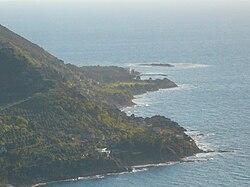Licosa
| Licosa | |
|---|---|
| Frazione | |

View of the promontory and the island
|
|
| Location of Licosa in Italy | |
| Coordinates: 40°15′12.17″N 14°54′23.08″E / 40.2533806°N 14.9064111°ECoordinates: 40°15′12.17″N 14°54′23.08″E / 40.2533806°N 14.9064111°E | |
| Country |
|
| Region |
|
| Province | Salerno (SA) |
| Comune | Castellabate |
| Elevation | 20 m (70 ft) |
| Population (2009) | |
| • Total | 82 |
| Demonym(s) | Leucosini / Licosani |
| Time zone | CET (UTC+1) |
| • Summer (DST) | CEST (UTC+2) |
| Postal code | 84048 |
| Dialing code | (+39) 0974 |
Licosa is a southern Italian village and hamlet (frazione) of Castellabate, a municipality in the province of Salerno, Campania. As of 2009 its population was of 82.
The toponym derives from the Greek word Λευκωσία (Leukosia, Lefkosía in Modern Greek), meaning "white". A legend says that Leucosia was one the 3 mythological sirens met by Ulysses in the Odyssey. The toponym is therefore related to Nicosia (Greek: Lefkosía, Turkish: Lefkoşa), capital of Cyprus, and to Nicosia, a town in Sicily.
The area, inhabited since the Upper Paleolithic, was settled by Oenotrians, Lucani (Leukànoi), Greeks and Romans; as witnessed by the ruins of the ancient Greek city of Leucosia, or Leukothèa. In 846 it was the site of a naval battle between the Saracens and the Duchy of Naples with allies.
The medieval fief of Licosa, established by the abbot Constabilis in 1123, was part of the baronage of Castello dell'Abate, and was administered by the abbots of La Trinità della Cava.
...
Wikipedia

